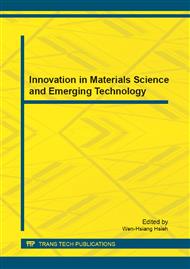p.359
p.364
p.369
p.374
p.379
p.384
p.390
p.395
p.400
Adaptive & Weighted Measures of Industry-Based R&D Performance Evaluation by Surveys for SMEs in 4 Selected Industries in Korea
Abstract:
It is difficult to evaluate R&D performance especially for companies’ R&D in various industries because each industry has different characteristics and specific industrial environments. R&D performance evaluation can be measured by its quantitative output and firms’ performance. In this paper, R&D performance evaluation for each industry is analyzed by the indices of quantitative output and outcome, and the differences among industries can be checked for the indices. That is, one index can stand out in an industry, but another one can be remarkable in other industries. Whether the differences for each index among industries exist can be checked. We surveyed four industries such as machinery, electronics, parts & materials and IT by scoring index method with weight factors. The survey was conducted for small & medium-sized enterprises (SMEs) in Korea focused on R&D performance evaluation indices classified by output and outcome result which are gained from several hundred firms. More sensitive indices are specified for each industry, and the indices can be used with higher priority for evaluating firm’s R&D performance. By further research of the differences for each industry, the weight for indices can be specified in each industry, and the evaluation among heterogeneous industries can be performed by normalizing indices.
Info:
Periodical:
Pages:
379-383
Citation:
Online since:
December 2011
Authors:
Price:
Сopyright:
© 2012 Trans Tech Publications Ltd. All Rights Reserved
Share:
Citation:


